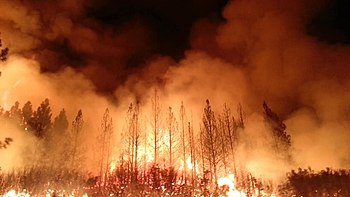Abstract:
This study measures the degree to which large public expenditures on wildfire protection subsidize development in harm's way. Using administrative firefighting data, we calculate geographically-differentiated implicit subsidies to homeowners throughout the western USA. We first examine how the presence of homes affects firefighting expenditures. These results are used to reconstruct the implied historical cost of protecting each home and to perform an actuarial calculation of expected future protection cost. The expected net present value of this subsidy can exceed 20% of a home's value. It increases with fire risk and decreases surprisingly steeply with development density. A simple model is used to explore effects on expansion of developed areas, density, and private risk-reducing investments. These results demonstrate how policy and institutions influence the costs imposed by a changing climate.
This study measures the degree to which large public expenditures on wildfire protection subsidize development in harm's way. Using administrative firefighting data, we calculate geographically-differentiated implicit subsidies to homeowners throughout the western USA. We first examine how the presence of homes affects firefighting expenditures. These results are used to reconstruct the implied historical cost of protecting each home and to perform an actuarial calculation of expected future protection cost. The expected net present value of this subsidy can exceed 20% of a home's value. It increases with fire risk and decreases surprisingly steeply with development density. A simple model is used to explore effects on expansion of developed areas, density, and private risk-reducing investments. These results demonstrate how policy and institutions influence the costs imposed by a changing climate.
 |
| The Rim Fire burned more than 250,000 acres (1,000 km2) of forest near Yosemite National Park, in 2013https://en.wikipedia.org/wiki/Wildfire |
...
During 1985–2017 total wildfire property damages in the United States were $51 billion, while direct firefighting costs for federal agencies alone totaled $43 billion.
...
A sample of homes including all 8.6 million homes in the western US located near areas of wildland vegetation (44% of all western US residential homes, condos, and apartments)....The range of historical protection costs is large. The average net present value ranges from a few hundred dollars per home for the lowest-cost cells to almost $100,000 per home in the highest-cost cells.
...
Using the “suppression only” measure, 50% of WUI homes have expected protection costs under $500, while the highest-risk homes have costs that are much larger. Five percent of homes have expected costs exceeding $3,800. One percent of homes have expected protection costs exceeding $12,700. Using the “suppression plus” measure results in higher costs. The 95th and 99th percentiles of this distribution are about twice as high as for the “suppression only” measure.
...
In 2014, California began requiring homeowners in the Cal Fire protection area to pay an equal annual fee of about $150 per year. The fee proved unpopular among homeowners and was suspended in 2017. This study shows that such a fee would need to be much more geographically differentiated in order to correct incentives (as opposed to simply raising revenue). Another lesson from this study is that exempting owners of existing homes could increase the political acceptability of such a policy without reducing its effectiveness, since the protection costs we estimate are not generally high enough to justify abandonment of existing homes. An alternative would be to assign firefighting costs to local governments, which would recover them through property taxes or other measures. This approach would incentivize cities and counties to consider fire protection costs in zoning, land use, and building codes/
https://www.nber.org/papers/w26550
by Patrick Baylis and Judson Boomhower
During 1985–2017 total wildfire property damages in the United States were $51 billion, while direct firefighting costs for federal agencies alone totaled $43 billion.
...
A sample of homes including all 8.6 million homes in the western US located near areas of wildland vegetation (44% of all western US residential homes, condos, and apartments)....The range of historical protection costs is large. The average net present value ranges from a few hundred dollars per home for the lowest-cost cells to almost $100,000 per home in the highest-cost cells.
...
Using the “suppression only” measure, 50% of WUI homes have expected protection costs under $500, while the highest-risk homes have costs that are much larger. Five percent of homes have expected costs exceeding $3,800. One percent of homes have expected protection costs exceeding $12,700. Using the “suppression plus” measure results in higher costs. The 95th and 99th percentiles of this distribution are about twice as high as for the “suppression only” measure.
...
In 2014, California began requiring homeowners in the Cal Fire protection area to pay an equal annual fee of about $150 per year. The fee proved unpopular among homeowners and was suspended in 2017. This study shows that such a fee would need to be much more geographically differentiated in order to correct incentives (as opposed to simply raising revenue). Another lesson from this study is that exempting owners of existing homes could increase the political acceptability of such a policy without reducing its effectiveness, since the protection costs we estimate are not generally high enough to justify abandonment of existing homes. An alternative would be to assign firefighting costs to local governments, which would recover them through property taxes or other measures. This approach would incentivize cities and counties to consider fire protection costs in zoning, land use, and building codes/
https://www.nber.org/papers/w26550
by Patrick Baylis and Judson Boomhower
National Bureau of Economic Research (NBER) www.NBER.org
NBER Working Paper No. 26550; Issued in December 2019
No comments:
Post a Comment